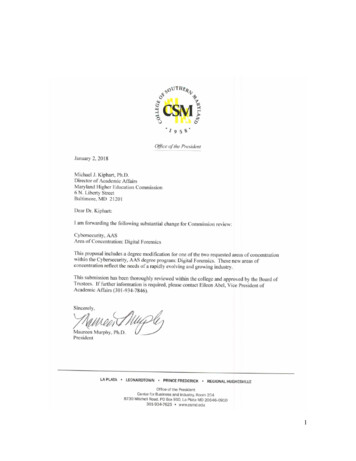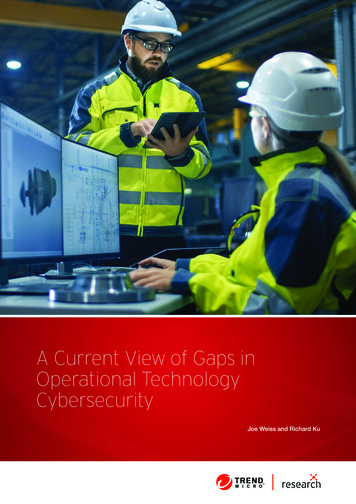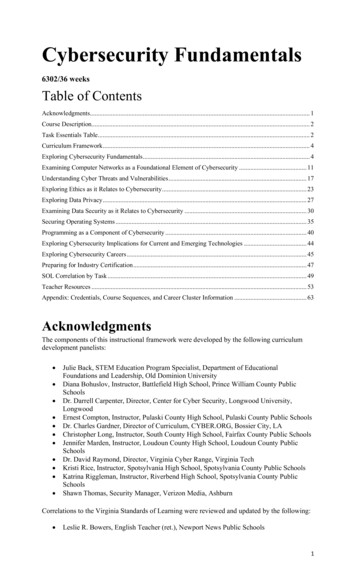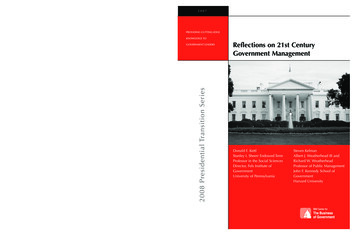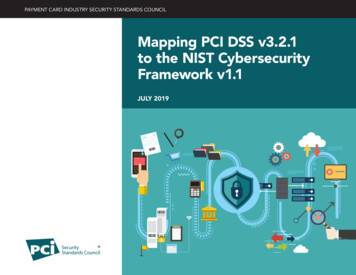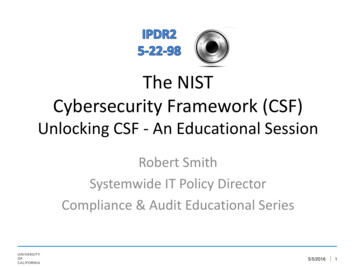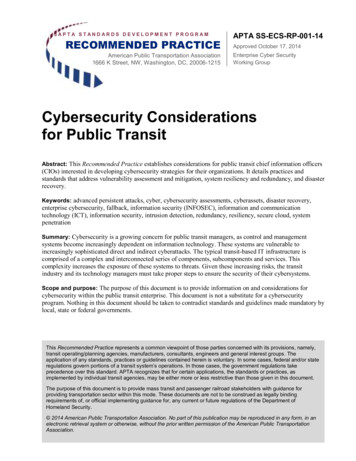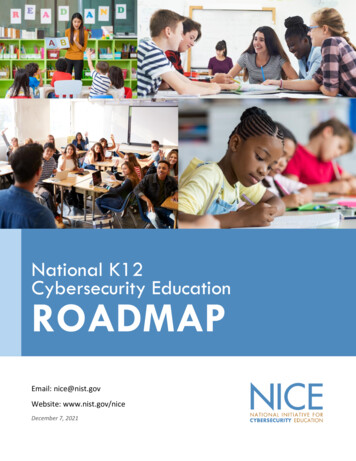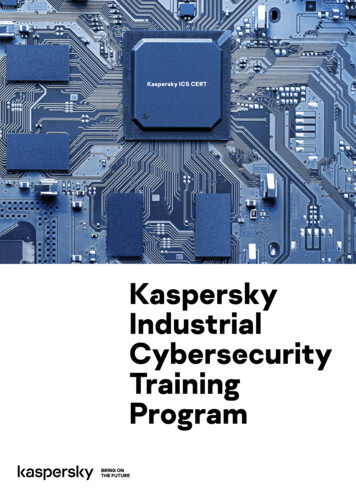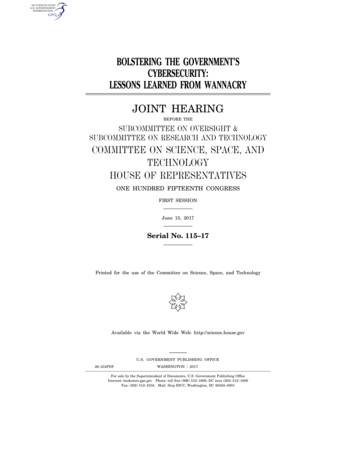
Transcription
BOLSTERING THE GOVERNMENT’SCYBERSECURITY:LESSONS LEARNED FROM WANNACRYJOINT HEARINGBEFORE THESUBCOMMITTEE ON OVERSIGHT &SUBCOMMITTEE ON RESEARCH AND TECHNOLOGYCOMMITTEE ON SCIENCE, SPACE, ANDTECHNOLOGYHOUSE OF REPRESENTATIVESONE HUNDRED FIFTEENTH CONGRESSFIRST SESSIONJune 15, 2017Serial No. 115–17Printed for the use of the Committee on Science, Space, and Technology(Available via the World Wide Web: http://science.house.govU.S. GOVERNMENT PUBLISHING OFFICE26–234PDFWASHINGTON:2017For sale by the Superintendent of Documents, U.S. Government Publishing OfficeInternet: bookstore.gpo.gov Phone: toll free (866) 512–1800; DC area (202) 512–1800Fax: (202) 512–2104 Mail: Stop IDCC, Washington, DC 20402–0001
COMMITTEE ON SCIENCE, SPACE, AND TECHNOLOGYHON. LAMAR S. SMITH, Texas, ChairFRANK D. LUCAS, OklahomaEDDIE BERNICE JOHNSON, TexasDANA ROHRABACHER, CaliforniaZOE LOFGREN, CaliforniaMO BROOKS, AlabamaDANIEL LIPINSKI, IllinoisRANDY HULTGREN, IllinoisSUZANNE BONAMICI, OregonBILL POSEY, FloridaALAN GRAYSON, FloridaTHOMAS MASSIE, KentuckyAMI BERA, CaliforniaJIM BRIDENSTINE, OklahomaELIZABETH H. ESTY, ConnecticutRANDY K. WEBER, TexasMARC A. VEASEY, TexasSTEPHEN KNIGHT, CaliforniaDONALD S. BEYER, JR., VirginiaBRIAN BABIN, TexasJACKY ROSEN, NevadaBARBARA COMSTOCK, VirginiaJERRY MCNERNEY, CaliforniaGARY PALMER, AlabamaED PERLMUTTER, ColoradoBARRY LOUDERMILK, GeorgiaPAUL TONKO, New YorkRALPH LEE ABRAHAM, LouisianaBILL FOSTER, IllinoisDRAIN LAHOOD, IllinoisMARK TAKANO, CaliforniaDANIEL WEBSTER, FloridaCOLLEEN HANABUSA, HawaiiJIM BANKS, IndianaCHARLIE CRIST, FloridaANDY BIGGS, ArizonaROGER W. MARSHALL, KansasNEAL P. DUNN, FloridaCLAY HIGGINS, LouisianaSUBCOMMITTEEONOVERSIGHTHON. DRAIN LAHOOD, Illinois, ChairBILL POSEY, FloridaDONALD S. BEYER, Jr., Virginia, RankingTHOMAS MASSIE, KentuckyMemberGARY PALMER, AlabamaJERRY MCNERNEY, CaliforniaROGER W. MARSHALL, KansasED PERLMUTTER, ColoradoCLAY HIGGINS, LouisianaEDDIE BERNICE JOHNSON, TexasLAMAR S. SMITH, TexasSUBCOMMITTEEONRESEARCHANDTECHNOLOGYHON. BARBARA COMSTOCK, Virginia, ChairFRANK D. LUCAS, OklahomaDANIEL LIPINSKI, IllinoisRANDY HULTGREN, IllinoisELIZABETH H. ESTY, ConnecticutSTEPHEN KNIGHT, CaliforniaJACKY ROSEN, NevadaDARIN LAHOOD, IllinoisSUZANNE BONAMICI, OregonRALPH LEE ABRAHAM, LouisianaAMI BERA, CaliforniaDANIEL WEBSTER, FloridaDONALD S. BEYER, JR., VirginiaJIM BANKS, IndianaEDDIE BERNICE JOHNSON, TexasROGER W. MARSHALL, KansasLAMAR S. SMITH, Texas(II)
CONTENTSJune 15, 2017PageWitness List .Hearing Charter .23Opening StatementsStatement by Representative Darin LaHood, Chairman, Subcommittee onOversight, Committee on Science, Space, and Technology, U.S. House ofRepresentatives .Written Statement .Statement by Representative Donald S. Beyer, Jr., Ranking Member, Subcommittee on Oversight, Committee on Science, Space, and Technology,U.S. House of Representatives .Written Statement .Statement by Representative Ralph Abraham, Vice Chairman, Subcommitteeon Research and Technology, Committee on Science, Space, and Technology,U.S. House of Representatives .Written Statement .Statement by Representative Daniel Lipinski, Ranking Member, Subcommittee on Research and Technology, Committee on Science, Space, andTechnology, U.S. House of Representatives .Written Statement .Statement by Representative Lamar S. Smith, Chairman, Committee onScience, Space, and Technology, U.S. House of Representatives .Written Statement .46910121416182022Witnesses:Mr. Salim Neino, Chief Executive Officer, Kryptos LogicOral Statement .Written Statement .Dr. Charles H. Romine, Director, Information Technology Laboratory, National Institute of Standards and TechnologyOral Statement .Written Statement .Mr. Gregory J. Touhill, CISSP, CISM; Brigadier General, USAF (ret); AdjunctProfessor, Cybersecurity & Risk Management, Carnegie Mellon University,Heinz CollegeOral Statement .Written Statement .Dr. Hugh Thompson, Chief Technology Officer, SymantecOral Statement .Written Statement .Discussion .242833354446545664Appendix I: Answers to Post-Hearing QuestionsDr. Charles H. Romine, Director, Information Technology Laboratory, National Institute of Standards and Technology .(III)82
IVPageMr. Gregory J. Touhill, CISSP, CISM; Brigadier General, USAF (ret); AdjunctProfessor, Cybersecurity & Risk Management, Carnegie Mellon University,Heinz College .Dr. Hugh Thompson, Chief Technology Officer, Symantec .8487Appendix II: Additional Material for the RecordStatement submitted by Representative Eddie Bernice Johnson, RankingMember, Committee on Science, Space, and Technology, U.S. House ofRepresentatives .90
BOLSTERING THE GOVERNMENT’SCYBERSECURITY:LESSONS LEARNED FROM WANNACRYThursday, June 15, 2017HOUSE OF REPRESENTATIVES,SUBCOMMITTEE ON OVERSIGHT ANDSUBCOMMITTEE ON RESEARCH AND TECHNOLOGYCOMMITTEE ON SCIENCE, SPACE, AND TECHNOLOGY,Washington, D.C.The Subcommittees met, pursuant to call, at 10:05 a.m., in Room2318 of the Rayburn House Office Building, Hon. Darin LaHood[Chairman of the Subcommittee on Oversight] presiding.(1)
2
3
4Chairman LAHOOD. The Subcommittee on Oversight and theSubcommittee on Research and Technology will come to order.Without objection, the Chair is authorized to declare a recess ofthe Subcommittee at any time.Good morning, and welcome to today’s hearing titled ‘‘Bolsteringthe Government’s Cybersecurity: Lessons Learned fromWannaCry.’’ I recognize myself for five minutes for an openingstatement.I want to welcome the witnesses here today, and I would alsowelcome Chairman Smith, Oversight Subcommittee Ranking Member Beyer, Research and Technology Subcommittee Vice ChairmanAbraham, Research and Technology Ranking Member Lipinski,Members of the Subcommittees, our expert witnesses, and members of the audience.Cybersecurity—a concept we hear mentioned frequently, especially in this period of rapidly emerging threats—is an ever-evolving concept. Maintaining an effective cybersecurity posture requiresconstant vigilance as new threats emerge and old ones return. Toooften, however, when we hear about the importance of cybersecurity, we are left without concrete steps to take to ensure our systems are best positioned to defend against emerging threats.One of the goals of today’s hearing is to learn about real, tangiblemeasures the government can take to ensure its IT security systems are appropriately reinforced to defend against new andemerging threats, including novel and sophisticated ransomwarethreats.The specific focus of today’s hearing will be the recent WannaCryransomware attack, a new type of ransomware infection, which affected over one million unique systems last month in a worldwideattack that impacted nearly every country in the world.Although the concept of ransomware is not new, the type ofransomware employed by WannaCry was novel. WannaCry workedby encrypting documents on a computer, instructing victims to pay 300 in Bitcoin in order to regain access to their user’s documents.Unlike typical forms of ransomware, however, WannaCry signaledthe ushering in of a new type of worming ransomware, whichcaused the attack to spread faster and more rapidly with each newinfection.In light of the novelty built into WannaCry’s method of attack,cybersecurity experts, including those we will hear from today,have expressed significant concerns that WannaCry is only a preview of a more sophisticated ransomware infection that many believe will inevitably be launched by hackers in the near future.Beginning May 12, 2017, the WannaCry ransomware infectionmoved rapidly across Asia and Europe, eventually hitting theUnited States. The attack infected 7,000 computers in the firsthour and 110,000 distinct IP addresses in 2 days and in almost 100countries, including the U.K., Russia, China, Ukraine, and India.Experts now believe WannaCry affected approximately 1 to 2 million unique systems worldwide prior to activating the kill switch.In Illinois, my home state, Cook County’s IT systems were compromised by WannaCry, reportedly one of a few local governmentssubject to the attack. Although Cook County has worked to appropriately patch their systems, it is important that we ensure that
5all vulnerabilities are appropriately remedied in the event of amore sophisticated attack.Fortunately, the hackers responsible for WannaCry mistakenlyincluded a kill switch, which was uncovered by an employee ofKryptos Logic and used to terminate the attack. The Kryptos Logicemployee exploited a key mistake made by the hackers when heregistered the domain connected to the ransomware attack. Expertsestimate that the kill switch prevented 10 to 15 million uniqueworldwide system infections and reinfections.Although based on information available thus far the federal government’s systems were fortunately spared from WannaCry, wewant to ensure that the government is sufficiently prepared in thelikely event of a more sophisticated attack.Additionally, the Committee wants to hear what Congress can doto appropriately address this Committee—I’m sorry—this climateof new and improving cybersecurity threats.Through the lens of the aftermath of WannaCry, today’s witnesses will help shed light on key steps the government shouldtake to ensure its systems are protected. We will also hear todayabout how public-private partnerships are an instrumental tool tohelp bolster the government’s cybersecurity posture. Finally, wewill learn about how the President’s recent cybersecurity order,which makes NIST’s cybersecurity framework mandatory on theExecutive Branch, is a significant step toward ensuring the federalgovernment’s cybersecurity posture incorporates the most innovative security measures to defend against evolving threats.It is my hope that our discussions here today will highlight areaswhere improvement is necessary, while offering recommendationsas we move forward to ensure the federal government is preparedto respond to emerging cybersecurity threats. I look forward tohearing from our distinguished witnesses.[The prepared statement of Chairman LaHood follows:]
6
7
8Chairman LAHOOD. I now recognize the Ranking Member of theOversight Subcommittee, Mr. Beyer, for an opening statement.Mr. BEYER. Thank you very much, Mr. Chairman. I’d like tothank you and Chairman Comstock for holding this hearing.Cybersecurity should be a chief concern for every government,business, and private citizen. In 2014, the Office of Personnel Management’s information security systems, and two of the systemsused by OPM contractors, were breached by state-sponsored hackers, compromising the personal information of millions of Americans. That same year, hackers released the personal information ofSony Pictures executives, embarrassing e-mails between Sony Pictures employees, and even copies of then-unreleased Sony movies.In 2015, hackers also took control of the power grid in westernUkraine and shut off power for over 200,000 residents. These threequick examples show the varied and widespread effects of cybersecurity breaches.So we know the cybersecurity breach that was the genesis forthis hearing was the WannaCry outbreak. WannaCry ransomwareinfected at least 300,000 computers worldwide, and could havebeen much worse, so I want to thank CEO Neino, head of KryptosLogic, for being wise enough to find an employee who found thatkill switch, unless you did it yourself. And we’re very lucky thatthat was found quickly, and we are fortunate that federal systemswere resistant to WannaCry. But we know we may not be as luckythe next time. We must continue to strengthen our cybersecurityposture.By the way, in preparing for this, I’ve learned from our wonderful staff that I really need to upload our security upgrades everytime we get a chance on our personal computers and on oursmartphones.The May 11th Executive Order on strengthening the cybersecurity of federal networks seeks to build on the Obama Administration’s successes in the cybersecurity arena, and I’m happy that theTrump Administration—I don’t agree with them on every topic—but they’ve taken this next good step. The Executive Order calls fora host of actions and a myriad of reports on federal cybersecurityfrom every government agency.Simultaneously, the Trump Administration has been slow to fillnewly vacant positions in nearly every government agency, and myconcern is that understaffed agencies are going to have significantdifficulty meeting the dictates of the Executive Order. Frankly, I’malso concerned that proposed budget cuts in the original TrumpMulvaney budget across all agencies will make the task a lot harder to strengthen the security of federal information systems. We’vegot to make sure that the federal government has the resourcesand staffing to meet the need in this vital area.The Executive Order also calls for agencies to begin using theNIST Framework for cybersecurity efforts, and I’m glad that wehave NIST here with us today. They play a very important role insetting cybersecurity standards that could help thwart and impedecyber-attacks.You know, NIST is world renowned for its expertise in standardsdevelopment, and federal agencies will be well served by using theNIST Framework. On a precautionary note, though, I believe some
9efforts to expand NIST’s cybersecurity role beyond their currentmission and expertise are well intentioned but perhaps misplaced.We recently had a debate of H.R. 1224 here, the ‘‘NIST Cybersecurity Framework, Assessment, and Auditing Act of 2017,’’ whichgives NIST auditing authority for all federal civilian informationsystems. Currently, this is a responsibility of the Inspector Generals at each agency. They have the statutory authority, the experience, the expertise. They respond directly, responsible to Congress.NIST has no such experience or expertise, and I at least remainconcerned about this proposal, and I’d be interested in any of theexpert witnesses’ thoughts on NIST’s role in cybersecurity and auditing.So I look forward to hearing from all of you today. I especiallylook forward to hearing from our General, the former federal CISO,about his experience in these positions and thoughts.One final note. Bloomberg reported this week that the Russianmeddling in our electoral system was far worse than what’s beenpreviously reported. According to the report, hackers attempted todelete or alter voter data, accessed software designed to be used bypoll workers, and, in at least one instance, accessed a campaign finance database. These efforts didn’t need to change individualvotes in order to influence the election, and we really should takethese sorts of cyber threats very seriously. I think Vice PresidentCheney called this a war on our democracy.So Mr. Chairman, this Committee held more than a half dozenhearings on cybersecurity issues during the last Congress, including one on protecting the 2016 elections from cyber and voting machine attacks, so given what we now know about the hacking andmeddling in 2016, I hope that this hearing today will be a precursor to more hearings on how we can better protect our votingsystems.Mr. Chairman, thank you so much, and I yield back.[The prepared statement of Mr. Beyer follows:]
10
11
12Chairman LAHOOD. Thank you, Mr. Beyer, for your openingstatement.I now recognize the Vice Chair of the Research and TechnologySubcommittee, Mr. Abraham, for an opening statement.Mr. ABRAHAM. Thank you, Mr. Chairman.Over the last few years, we’ve seen an alarming increase in thenumber and intensity of our cyber-attacks. These attacks by cybercriminals and by unfriendly governments have compromised thepersonal information of millions of Americans, jeopardized thousands of our businesses and their employees, and threatened interruption of critical public services.The recent WannaCry ransomware attack demonstrates thatcyber-attacks are continuing to go from bad to worse. This most recent large-scale cyber-attack affected more than one to two millionsystems in more than 190 countries. Nevertheless, it appears thatthe impact could have been much more catastrophic consideringhow fast that ransomware spread.And while organizations and individuals within the UnitedStates were largely unscathed, due in part to a security researcheridentifying a web-based ‘‘kill switch,’’ the potential destructivenessof WannaCry warns us to expect similar attacks in the future. Before those attacks happen, we need to make sure that our information systems are very ready.During a Research and Technology Subcommittee hearing earlierthis year, a witness representing the U.S. Government Accountability Office—the GAO—testified, and I quote, ‘‘Over the past several years, GAO has made about 2,500 recommendations to federalagencies to enhance their information security programs and controls. As of February 2017, about 1,000 recommendations had notbeen implemented.’’It is clear that the status quo in federal government cyber security is a virtual invitation for more cyber-attacks. We must takestrong steps in order to properly secure our systems and databasesbefore another cyber-attack like WannaCry happens and puts ourgovernment up for ransom.On March 1, 2017, this Committee approved H.R. 1224, the NISTCybersecurity Framework, Assessment, and Auditing Act of 2017,a bill that I introduced as part of my ongoing interest over thestate of our nation’s cybersecurity. This bill takes concrete steps tohelp strengthen federal government cybersecurity. The most important steps are encouraging federal agencies to adopt the NationalInstitute of Standards and Technology’s (NIST) CybersecurityFramework, which is used by many private businesses, and directing NIST to initiate individual cybersecurity audits of priority federal agencies to determine the extent to which each agency is meeting the information security standards developed by the Institute.NIST’s in-house experts develop government-wide technical standards and guidelines under the Federal Information Security Modernization Act of 2014. And NIST experts also developed, throughcollaborations between government and private sector, the Framework for Improving Critical Infrastructure Cybersecurity that federal agencies are now required to use pursuant to the President’srecent Cybersecurity Executive Order. I was very pleased to readthat language.
13Considering the growing attempts to infiltrate information systems, there is an urgent need to assure Americans that all federalagencies are doing everything that they can to protect governmentnetworks and sensitive data. The status quo simply is not working.We can’t put up with more bureaucratic excuses and delays.NIST’s cyber expertise is a singular asset. We should take fulladvantage of that asset, starting with the very important step ofannual NIST cyber audits of high priority federal agencies.As cyber-attacks and cyber criminals continue to evolve and become more sophisticated, our government’s cyber defenses mustalso adapt in order to protect vital public services and shield hundreds of millions of Americans’ confidential information.We will hear from our witnesses today about lessons learnedfrom the WannaCry attack and how the government can bolsterthe security of its systems. We must keep in mind that the nextcyber-attack is just around the corner, and it could have a fargreater impact than what we have seen thus far. Our federal government—our government systems need to be better protected, andthat starts with more accountability, responsibility, and transparency by federal agencies.Thank you, and I look forward to hearing our panel.[The prepared statement of Mr. Abraham follows:]
14
15
16Chairman LAHOOD. Thank you, Mr. Abraham.I now recognize the Ranking Member of the Research and Technology Subcommittee, my colleague from Illinois, Mr. Lipinski, foran opening statement.Mr. LIPINSKI. Thank you, Chairman LaHood, and I want tothank you and Vice Chair Abraham for holding this hearing on cybersecurity and lessons learned from the WannaCry ransomwareattack last month.The good news is that U.S. government information systemswere not negatively impacted by the WannaCry attack. This wasa clear victory for our cyber defenses. However, I believe there arelessons to be learned from successes as well as failures. A combination of factors likely contributed to this success, including gettingrid of most of our outdated Windows operating systems, diligentlyinstalling security patches, securing critical IT assets, and maintaining robust network perimeter defenses.As we know, Microsoft sent out a security patch for this vulnerability in March, two months before the WannaCry attack. Theseand other factors played a role in minimizing damage to U.S. businesses as well. However, WannaCry and its impact on other countries serves as yet another reminder that we must never be complacent in our cybersecurity defenses. The threats are ever evolving, and our policies must be robust yet flexible enough to allowour defenses to evolve accordingly.The Federal Information Security Modernization Act, or FISMA,laid out key responsibilities for the security of civilian informationsystems. Under FISMA, DHS and OMB have central roles in development and implementation of policies as well as in incident tracking and response. NIST develops and updates security standardsand guidelines both informing and responsive to the policies established by OMB. Each agency is responsible for its own FISMA compliance, and each Office of Inspector General is required to auditits own agency’s compliance with FISMA on an annual basis. Wemust continue to support agencies in their efforts to be compliantwith FISMA while conducting careful oversight.In 2014, NIST released the Cybersecurity Framework for CriticalInfrastructure, which is currently being updated to FrameworkVersion 1.1. While it is still too early to evaluate its full impact,it appears the Framework is being widely used across industry sectors.Our Committee recently reported out a bipartisan bill, H.R. 2105,that I was pleased to cosponsor, that would ensure that the Cybersecurity Framework is easily usable by our nation’s small businesses. I hope we can get it to the President’s desk quickly. In themeantime, the President’s recent cybersecurity Executive Order directs federal agencies to use the Framework to manage their owncybersecurity risk. As we have heard in prior hearings, many experts have called for this step, and I applaud the Administrationfor moving ahead.I join Mr. Beyer in urging the Administration to fill the many vacant positions across our agencies that would be responsible for implementing the Framework as well as shepherding the myriad reports required by the Executive Order.
17Finally, I will take this opportunity to express my disappointment in the Administration’s budget proposal for NIST. The topline budget cut of 25 percent was so severe that if it were implemented, NIST would have no choice but to reduce its cybersecurityefforts. This represents the epitome of penny-wise, pound-foolishdecision making. NIST is among the best of the best when it comesto cybersecurity research and standards, and our modest taxpayerinvestment in their efforts helps secure the information systemsnot just of our federal government, but our entire economy. I trustthat my colleagues will join me in ensuring that NIST receives robust funding in the fiscal year 2018 budget and doesn’t suffer thedrastic cut requested by the President.Thank you to the expert witnesses for being here this morning,and I look forward to your testimony. I yield back.[The prepared statement of Mr. Lipinski follows:]
18
19
20Chairman LAHOOD. Thank you, Mr. Lipinski.At this time I now recognize the Chairman of the full Committee,Mr. Smith.Chairman SMITH. Thank you, Mr. Chairman. I appreciate yourholding this hearing as well as the Research and Technology Subcommittee Vice Chairman sitting next to me, Ralph Abraham, forholding the hearing as well.In the wake of last month’s WannaCry ransomware attack, today’s hearing is a necessary part of an important conversation thefederal government must have as we look for ways to improve ourfederal cybersecurity posture. While WannaCry failed to compromise federal government systems, it is almost certain that outcome was due in part to a measure of chance.Rather than seeing this outcome as a sign of bulletproof cybersecurity defenses, we must instead increase our vigilance to betteridentify constantly evolving cybersecurity threats. This is particularly true since many cyber experts predict that we will experiencean attack similar to WannaCry that is more sophisticated in nature, carrying with it an even greater possibility of widespread disruption and destruction. Congress should not allow cybersecurity tobe ignored across government agencies.I am proud of the work the Committee has accomplished to improve the federal government’s cybersecurity posture. During thelast Congress, the Committee conducted investigations into theFederal Deposit Insurance Corporation, the Internal Revenue Service, and the Office of Personnel Management, as well as passed keylegislation aimed at providing the government with the tools itneeds to strengthen its cybersecurity posture.President Trump understands the importance of bolstering ourcybersecurity. He signed a recent Executive Order on cybersecurity,which is a vital step towards ensuring the federal government ispositioned to detect, deter, and defend against emerging threats.Included in the President’s Executive Order is a provision mandating that Executive Branch departments and agencies implementNIST’s Cybersecurity Framework. While continuously updating itsCybersecurity Framework, NIST takes into account innovative cybersecurity measures from its private-sector partners. NIST’s collaborative efforts help to ensure that those entities that follow theFramework are aware of the most pertinent, effective, and cuttingedge cybersecurity measures. I strongly believe the President’s decision to make NIST’s Framework mandatory for the federal government will serve to strengthen the government’s ability to defendits systems against advanced cyber threats like with the recentWannaCry ransomware attack.Similarly, the Committee’s NIST Cybersecurity Framework, Assessment, and Auditing Act of 2017, sponsored by RepresentativeAbraham, draws on findings from the Committee’s numerous hearings and investigations related to cybersecurity, which underscorethe immediate need for a rigorous approach to protecting U.S. cybersecurity infrastructure and capabilities.Like the President’s recent Executive Order, this legislation promotes federal use of the NIST Cybersecurity Framework by providing guidance that agencies may use to incorporate the Framework into risk mitigation efforts. Additionally, the bill directs NIST
21to establish a working group with the responsibility of developingkey metrics for federal agencies to use.I hope that our discussions here today will highlight distinctareas where cybersecurity improvement is necessary, while offeringrecommendations to ensure cybersecurity objectives stay at theforefront of our national security policy discussions.And with that, I’ll yield back, Mr. Chairman.[The prepared statement of Chairman Smith follows:]
22
23
24Chairman LAHOOD. Thank you, Chairman Smith.At this time let me introduce our witnesses here today.Our first witness is Mr. Salim Neino, Founder and Chief Executive Officer of Kryptos Logic. Mr. Neino is credited with discoveringnew solutions for companies such as IBM, Dell, Microsoft, andAvaya. He received his bachelor’s degree in computer science fromCalifornia State University at Long Beach. A Kryptos Logic employee, as we’ve discussed, in the U.K. is credited with largely stopping the WannaCry attack. We’ll he
hour and 110,000 distinct IP addresses in 2 days and in almost 100 countries, including the U.K., Russia, China, Ukraine, and India. Experts now believe WannaCry affected approximately 1 to 2 mil-lion unique systems worldwide prior to activating the kill switch. In Illinois, my home state, Cook County's IT systems were com-


